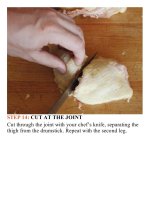The food lab better home cooking through science ( PDFDrive ) 60
Bạn đang xem bản rút gọn của tài liệu. Xem và tải ngay bản đầy đủ của tài liệu tại đây (177.33 KB, 2 trang )
(polyethylene) and wood are the only ones you should
consider.A glass cutting board is like death to your blade:
slow, painful, agonizing death as, stroke after stroke, the
perfect edge that you worked so hard to achieve is
relentlesslywornaway.Afewyearsback,ifyou’daskeda
health expert which type to use, they would have said
plastic, not wood. Plastic is inert and inhospitable to
bacteria, they’d say, whereas wood can house dangerous
bacteriaandtransferthemtoyourfood.
Turnsoutthosehealthexpertswerewrong.Anumberof
recentairtightstudieshaveshownthatwoodisactuallyless
likely to be a means of transferring bacteria, due to its
natural antimicrobial properties. A wooden cutting board
can be a death trap for bacteria. So long as you give it a
scrub and a thorough drying after each use (which, of
course, you should do with plastic boards as well), it’s a
perfectlysafematerial.
As for its actual function as a cutting surface, wood also
takes home the gold, with some modern plastic boards
coming in a close second.Wood is very soft, meaning that
your knife can make great contact with every stroke, but it
also has some self-healing properties—stroke marks will
close up and fade away (though with repeated use, your
boardwillbecomethinnerandthinner).
I’m lucky enough to have a few large, heavy, butcherblock–style boards, which I received as a gift from an old
chef of mine, that exactly fit my prep area. The best
commercial models I’ve seen are the ones made by
IronwoodGourmet.Theyhavea20-by-14-inchversionfor
about$50that’lllastyouatleasthalfalifetime.Don’thave
thedoughtospend?Aplasticoneisnotideal,butitwilldo
just fine.The OXO Good Grips 15-by-21-inch version is a
quarterofthecostandagreatvalue.
With a wooden board, you’ll want a small bottle of
mineraloiltorubintothesurfacewithasoftclothorpaper
towelaftereachusetopreventstainingandenhanceitslife.
FEELINGSHARP
T
here is nothing more frustrating than a dull
knife.Notonlydoesitmakeprepworkachoreand
your finished product less attractive, it’s also
downright dangerous. A dull blade requires more
pressuretocutintoafood,anditcaneasilyslipoffa
toughonionskin,forexample,andintoyourfinger.
Ouch.Mosthomecooksshouldsharpentheirknives
at least twice a year, much more frequently if they
usetheirkniveseveryday.Therearethreewaysto
goaboutit.
Method 1: Use an Electric Sharpener. A goodqualityelectricsharpenerisanoption,butIstrongly
discourage their use. First off, they remove a
tremendous amount of material from your edge.
Sharpen your knife a dozen times, and you’ll have
lost a good ½ centimeter of width, throwing it off
balanceandrenderinganybladewithabolster(i.e.,









